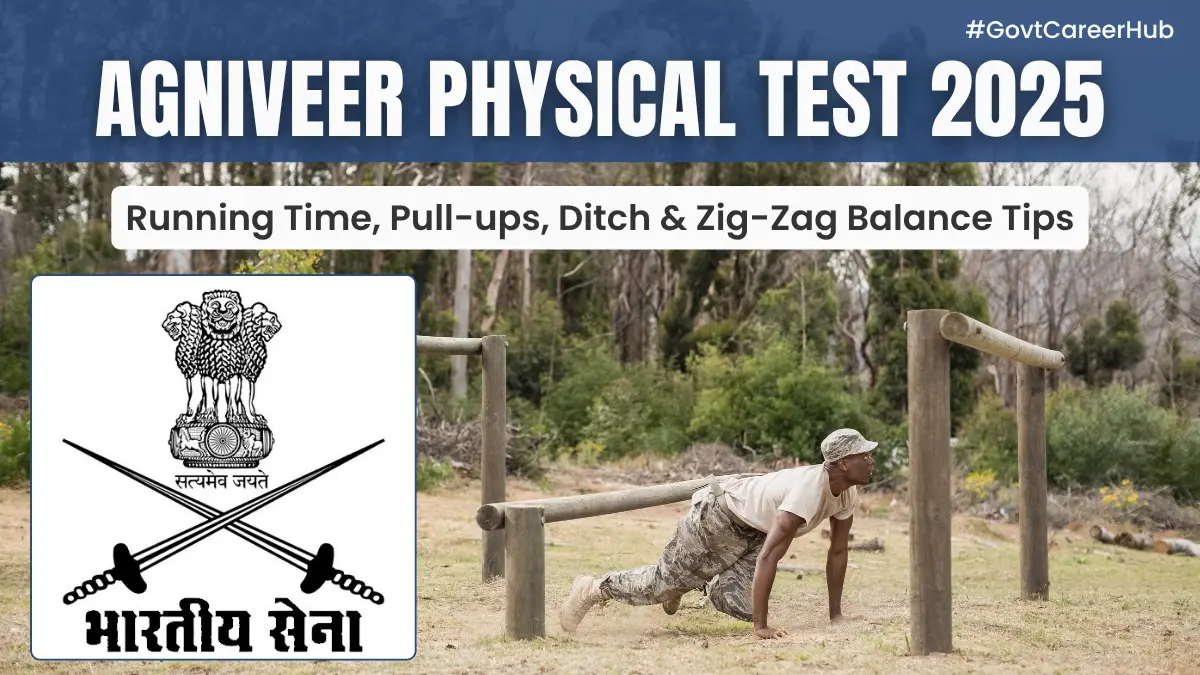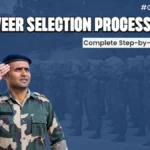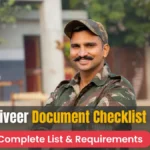Last Updated: July 24, 2025 at 4:47 pm
The Agniveer Physical Fitness Test remains one of the most challenging hurdles for candidates aspiring to join the Indian Army in 2025. With thousands of young Indians competing for limited positions, mastering the physical requirements becomes crucial for success. Before attempting the physical test, ensure you meet the Agniveer eligibility criteria and have completed your Agniveer application process successfully. This comprehensive guide will walk you through every aspect of the Agniveer PFT, providing practical strategies and training techniques that can make the difference between selection and rejection.
Understanding the Agniveer Physical Test Structure
The Indian Army Agniveer Physical Fitness Test comprises four distinct components that collectively evaluate a candidate’s overall fitness and military readiness. For complete details about the recruitment process, refer to the official Indian Army recruitment website. The Indian Army Agniveer Physical Fitness Test will include a 1.6 Km run, Beam (Pull Ups), 9 Feet Ditch and Zig Zag Balance. Each component serves a specific purpose in assessing different aspects of physical capability required for military service.
Physical Test Components Overview
The PFT evaluation system has been designed to test cardiovascular endurance, upper body strength, agility, and balance. Understanding the scoring mechanism helps candidates prioritise their training efforts effectively. The total marks allocated for the Physical Fitness Test is 100, distributed across all four events based on performance levels.
1.6 KM Running Test: Time Requirements and Training Strategy
The running component forms the backbone of the Agniveer physical assessment, testing cardiovascular fitness and mental resilience. Practice running 1.6 km daily and aim to complete it within 5 minutes 30 seconds. However, the qualifying time standards vary, with candidates must complete the 1.6 km run within 5 minutes 45 seconds being the minimum requirement.
Effective Running Training Programme
Creating a structured running routine requires progressive overload and varied training methods. For detailed running training plans, check our comprehensive guide on Agniveer physical fitness preparation. Start with a baseline assessment of your current 1.6 km time, then implement interval training three times per week. Focus on 400-meter repeats at target pace, with equal rest periods between repetitions.
Long-distance runs should be incorporated twice weekly, covering 3-5 kilometres at a comfortable pace. This builds aerobic capacity and mental toughness essential for maintaining speed throughout the test distance. Wednesday sessions can include tempo runs, maintaining a challenging but sustainable pace for 20-25 minutes.
Recovery plays an equally important role in running improvement. Schedule rest days between intense sessions, using light jogging or walking for active recovery. Proper hydration and nutrition support consistent training progression.
Race Day Running Strategy
Pacing strategy determines success in the 1.6 km test. Divide the distance into four 400-meter segments, starting slightly faster than target pace to establish position. Maintain steady effort through the middle 800 meters, conserving energy for a strong finish.
Mental preparation involves visualising successful completion and developing positive self-talk phrases. Practice breathing techniques during training runs, establishing rhythm patterns that can be replicated during the actual test.
Pull-ups (Beam Test): Building Upper Body Strength
Upper body strength assessment through pull-ups evaluates functional fitness critical for military tasks. A minimum of 6 pull-ups is required to qualify. However, aiming for higher numbers provides better scoring opportunities and demonstrates superior fitness levels.
Progressive Pull-up Training Method
Building pull-up capacity requires systematic strength development starting with assisted variations. Begin with resistance band assistance or partner-supported pull-ups, focusing on full range of motion and proper form. Gradually reduce assistance as strength improves.
Negative pull-ups prove particularly effective for strength building. Jump or step up to the top position, then lower yourself slowly over 5-8 seconds. This eccentric movement pattern develops the muscle control necessary for complete pull-ups.
Incorporate complementary exercises including lat pulldowns, bent-over rows, and dead hangs. These movements strengthen the same muscle groups while providing training variety and preventing overuse injuries.
Pull-up Technique Optimisation
Proper technique maximises efficiency and prevents early fatigue. Start from a dead hang position with arms fully extended, then pull upward until the chin clears the bar. Control the descent to maintain muscle tension throughout the movement.
Grip width should approximate shoulder width, with palms facing away from the body. Avoid swinging or using momentum, as this reduces training effectiveness and may result in test disqualification.
9 Feet Ditch Crossing: Explosive Power Development
The ditch crossing event tests explosive leg power and jumping technique. Ditch: 09 Feet (qualifying in nature) This means candidates must successfully clear the 9-foot distance to continue in the selection process.
Plyometric Training for Ditch Crossing
Developing explosive power requires specific plyometric exercises that improve fast-twitch muscle fiber recruitment. Box jumps, broad jumps, and bounding exercises directly translate to improved ditch crossing performance.
Start with standing broad jumps, measuring distance and focusing on landing technique. Progress to multiple consecutive bounds, maintaining distance while improving rhythm and coordination. Single-leg hops develop unilateral strength and balance.
Depth jumps from modest heights (12-18 inches) teach rapid muscle activation patterns. Step off the platform, land softly, then immediately explode into a maximum broad jump. This reactive strength directly applies to ditch crossing success.
Ditch Crossing Technique
Approach speed significantly impacts jumping distance. Develop a consistent run-up pattern, accelerating through the final steps before takeoff. The penultimate step should be slightly longer, setting up optimal takeoff angle.
Takeoff technique involves driving the lead knee upward while extending the trailing leg completely. Arm swing provides additional momentum, driving backward during takeoff then forward during flight. Land with both feet simultaneously, maintaining balance to demonstrate control.
Zig-Zag Balance Test: Coordination and Agility
The balance component evaluates neuromuscular coordination and spatial awareness essential for military movement patterns. This test requires navigating a narrow beam while changing direction, challenging both balance and agility simultaneously.
Balance Training Fundamentals
Proprioceptive training improves balance by enhancing the body’s position awareness. Single-leg stands progress to eyes-closed variations, then unstable surface training. Balance boards and stability balls provide progressive challenges.
Dynamic balance exercises better replicate test conditions. Walking lunges with direction changes, single-leg deadlifts, and lateral bounds develop functional balance skills. These movements require constant balance adjustments similar to the zig-zag test.
Core strength underlies all balance activities. Plank variations, side planks, and rotational exercises build the stability necessary for maintaining control during directional changes.
Zig-Zag Navigation Strategy
Successful beam navigation requires controlled movement and visual focus. Look ahead to the next turn rather than down at feet, allowing peripheral vision to guide foot placement. Shorter, controlled steps provide better stability than long strides.
Approach each direction change gradually, shifting weight smoothly rather than abruptly. Practice the specific turning pattern on the ground before attempting on an elevated beam. This familiarity reduces test anxiety and improves confidence.
Training Schedule and Periodisation
Effective preparation requires structured training progression over 8-12 weeks. Week 1-3 focuses on building aerobic base and basic strength. Weeks 4-6 introduce sport-specific exercises and increase training intensity. Weeks 7-9 peak physical preparation while practicing test events. Final weeks emphasise maintenance and recovery.
Weekly Training Structure
Monday sessions emphasise running endurance with 30-40 minute steady runs. Tuesday focuses on upper body strength including pull-up progressions and complementary exercises. Wednesday combines speed work with agility training. Thursday targets explosive power through plyometric exercises. Friday provides active recovery with light movement and stretching. Weekend sessions allow for longer runs and skill practice.
Nutrition and Recovery Considerations
Proper nutrition supports training adaptations and recovery. For detailed nutrition guidelines for defence aspirants, read our Indian Army diet and nutrition guide. Emphasise complex carbohydrates for energy, lean proteins for muscle repair, and adequate hydration throughout training. Time nutrient intake around training sessions for optimal benefit. According to the National Institute of Nutrition, balanced nutrition plays a crucial role in athletic performance and recovery.
Sleep quality directly impacts physical performance and adaptation. Aim for 7-9 hours nightly, maintaining consistent sleep schedules. Recovery techniques including stretching, foam rolling, and massage prevent overuse injuries.
Common Training Mistakes to Avoid
Many candidates focus exclusively on running while neglecting other test components. Balanced training addressing all four events prevents weak areas from limiting overall performance. Overtraining represents another common error, with excessive volume hindering rather than helping improvement.
Technique development often receives insufficient attention compared to fitness building. Poor movement patterns limit performance potential and increase injury risk. Regular technique assessment and correction ensure optimal training transfer.
Mental Preparation Strategies
Physical preparation alone cannot guarantee success without proper mental preparation.Visualisation techniques help candidates mentally rehearse successful test completion, building confidence and reducing anxiety. Practice positive self-talk phrases that can be used during challenging moments.
Stress management becomes crucial as test dates approach. According to research published in the Journal of Sports Sciences, mental preparation significantly impacts physical performance outcomes. Deep breathing exercises, progressive muscle relaxation, and mindfulness meditation help control pre-test nerves. Developing routine pre-performance rituals creates familiarity and calm.
Final Preparation Week
The week before testing requires careful balance between maintaining fitness and ensuring adequate recovery. Reduce training volume while maintaining intensity through brief, high-quality sessions. Practice all test events at reduced volume to maintain familiarity without creating fatigue.
Nutrition becomes particularly important, emphasising easily digestible foods and adequate hydration. Avoid dietary experiments or unusual foods that might cause digestive issues. Plan test day nutrition including pre-test meals and hydration strategies.
Equipment preparation includes ensuring proper footwear is broken in and comfortable. Practice with identical clothing and gear to be used on test day. Prepare backup options for all equipment items.
Test Day Execution Tips
Arrive early to allow for proper warm-up and mental preparation. Follow established warm-up routines practiced during training, avoiding new activities that might cause problems. Stay hydrated but avoid excessive fluid intake immediately before testing.
During the test, focus on executing practiced techniques rather than comparing performance to other candidates. Trust your preparation and maintain positive attitude throughout all events. If one event doesn’t go perfectly, refocus energy on remaining components.
Success Stories and Motivation
Remember that thousands of candidates have successfully cleared these physical standards through dedicated preparation. Your commitment to structured training and continuous improvement positions you for success. Each training session builds towards your goal of serving the nation through the Agniveer programme.
The physical fitness test represents just one step in your military journey. The discipline, determination, and resilience developed through preparation serve you throughout military service and beyond. Embrace the challenge as an opportunity to discover your physical potential.
Conclusion
Success in the Agniveer Physical Fitness Test 2025 requires comprehensive preparation addressing all test components. Running endurance, upper body strength, explosive power, and balance each demand specific training approaches and techniques. Structured preparation over adequate time periods, combined with proper nutrition and recovery, maximises your chances of achieving qualifying standards.
Remember that physical preparation extends beyond just meeting minimum requirements. Superior fitness levels provide advantages throughout military training and service. Commit to the process, trust your preparation, and execute with confidence. Your dedication to excellence in physical preparation reflects the commitment necessary for successful military service.
The path to becoming an Agniveer demands sacrifice, discipline, and unwavering determination. Your physical preparation journey builds not just fitness, but character traits essential for military leadership. Embrace this challenge as the first step towards serving your nation with honour and distinction.
Frequently Asked Questions (FAQs)
Related Articles:
- Agniveer Salary and Benefits 2025
- Indian Army Agniveer Training Duration
- Agniveer vs Regular Army Comparison
This comprehensive guide provides the foundation for successful Agniveer Physical Test preparation. Remember to consult with fitness professionals and medical advisors before beginning intensive training programmes. Your commitment to excellence starts with proper preparation.





